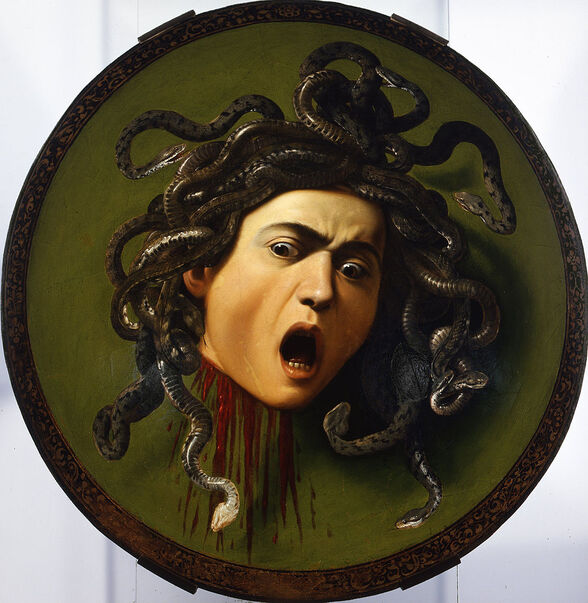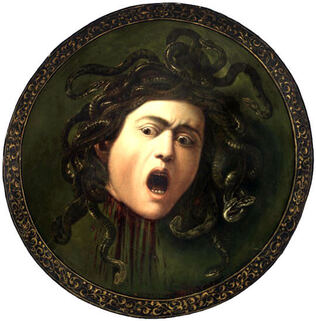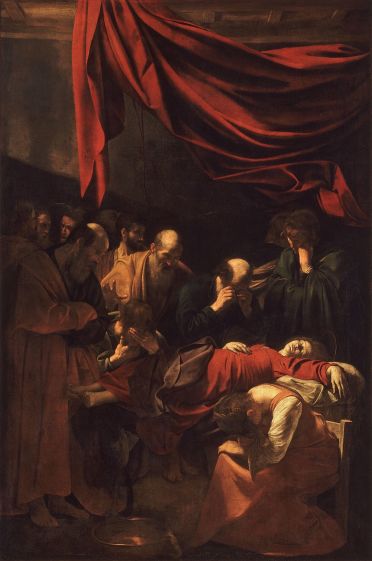|
Where? Room 96 of the Uffizi Museum
When? 1597 Commissioned by? Cardinal del Monte, who gave it as a gift to Ferdinando I de Medici, the Grand Duke of Tuscany What do you see? A depiction of the head of Medusa painted on a circular and curved wooden shield. Medusa is a figure described in Greek mythology. With her glance she could turn people who looked at her into stone. Instead of normal hair she has living, venomous snakes on her head. The snakes are watersnakes from the Tiber river as those were the best type of snakes Caravaggio could find nearby. I count at least eight snakes on her head. The blood streams out of her head as she has just been killed by the Greek demigod Perseus. This painting shows the moment that Medusa is looking at the reflective shield that Perseus is holding (which according to the myth actually happened just before she got beheaded). She realizes that her head is separated from her body, but that she is still conscious. You can see this realization by the horror in her eyes. As the painting is created on a shield, Caravaggio’s idea was that this painting actually represents the view of the shield as held by Perseus just after he killed Medusa. It is also interesting to have a closer look at Caravaggio’s use of light and shadow in this painting. Do you see how Caravaggio used these contrasts to show the head of Medusa as a three-dimensional object?
Who is Caravaggio? Michelangelo Merisa da Caravaggio (1571-1610) was trained by Simone Peterzano, who was in turn trained by Titian. He used a realistic painting style, paying attention to both the physical and emotional state of the subjects he painted. He combined this with a beautiful contrast between light and shadow in his paintings. He was a brilliant and unconventional artist.
During his life he received quite some commissions for religious paintings. However, Caravaggio always knew to how add some dark elements to the painting. He liked to use beggars, criminals, and prostitutes as models for his paintings, which would often give unexpected outcomes for familiar biblical scenes. Two beautiful examples of his religious paintings are the Death of the Virgin in the Louvre and The Entombment of Christ in the Vatican Museums.
Who is Medusa? In Greek mythology, Medusa was one of three sisters (Stheno, Euryale, and Medusa) who were often referred to as Gorgons. Both Stheno and Euryale were immortal, but Medusa was not. They were daughters of Phorcys (a sea god) and his sister Ceto (a sea goddess).
According to the Roman poet Ovid, Medusa was a beautiful young woman. However, after Poseidon (the god of the sea) made love to her in Athena’s temple, Athena (the goddess of wisdom and war) changed her beautiful locks into living, venomous snakes (in other mythological stories the three sisters were already born with snakes on their heads). Medusa had a horrific facial expression that could turn people (or according to some, only men) who looked at her into stone. The Greek hero Perseus, a demigod, used a shining shield that he got from the goddess Athena to avoid looking at her directly and succeeded to cut off her head. He used her head as a weapon afterwards as it retained its power to turn people who looked at it into stone. Perseus ultimately gave the head of Medusa to the goddess Athena, who placed the head on her shield (which is what is depicted in this painting). When the head of Medusa was cut off, two creatures arose from Medusa’s body: Pegasus, a winged horse, and Chryasor, a giant with a golden sword. Medusa in art? Medusa has been a popular subject in art. Famous artists have used her story as the inspiration for their artwork. Well known versions include:
Fun fact: Monica Favaro and colleagues published an academic study about the materials that were used in this painting and the evolution of these materials over time.
Interested in a copy for yourself? Poster or canvas (Amazon links).
Written by Eelco Kappe
References:
2 Comments
Merope
2/4/2021 09:27:47 am
You mention that Poseidon "made love" to Medusa which actually is not accurate. Poseidon raped Medusa for which she, but not him , was punished.
Reply
Eelco Kappe
2/5/2021 02:27:21 pm
Thank you for your feedback! There are various sources about their relationship and from them it is not completely clear whether Medusa gave her consent to Poseidon. So, you may be right, that he forced himself upon her, but it is not totally clear to me from the source texts.
Reply
Leave a Reply. |
Categories
All
|
- Home
- Blog
-
Museums
- Alte Pinakothek
- Art Institute of Chicago
- Baltimore Museum of Art
- Barber Institute of Fine Arts
- Bargello
- Barnes Foundation
- British Museum
- Church of Sant’Anastasia
- Cleveland Museum of Art
- Courtauld Institute of Art
- Detroit Institute of Arts
- Frans Hals Museum
- Galleria Borghese
- Gallerie dell'Accademia
- Getty Museum
- Guggenheim
- Hermitage Museum
- Kunsthistorisches Museum
- Kunstmuseum Basel
- Legion of Honor Museum
- Louvre
- Mauritshuis
- Metropolitan Museum of Art
- Musee d’Orsay
- Museum of Fine Arts in Boston
- Museum of Modern Art
- National Gallery in London
- National Gallery of Art
- National Museum in Poznań
- Norton Simon Museum
- Ny Carlsberg Glyptotek
- Palace of Versailles
- Palazzo Pitti
- Palazzo Vecchio
- Petit Palais
- Philadelphia Museum of Art
- Prado
- Pushkin Museum
- Ravenna Art Museum
- Rijksmuseum
- San Diego Museum of Art
- Santa Maria delle Grazie
- St. Peter's Basilica
- Städel Museum
- Statens Museum for Kunst
- Tate Britain
- Tate Modern
- Timken Museum of Art
- Uffizi
- Vatican Museums
- Wallace Collection
-
Artists
- Altdorfer
- Anguissola
- Berlin Painter
- Bosch
- Botticelli
- Boucher
- Bronzino
- Bruegel the Elder
- Brunelleschi
- Cabanel
- Caillebotte
- Canova
- Caravaggio
- Carpeaux
- Cezanne
- Cimabue
- David
- Degas
- Delacroix
- De Maria
- Donatello
- El Greco
- Fontana
- Fra Angelico
- Fragonard
- Gauguin
- Gentileschi
- Gericault
- Gonzalez-Torres
- Goya
- Hals
- Hogarth
- Hokusai
- Ingres
- Leonardo da Vinci
- Lippi, Filippo
- Longhi, Barbara
- Lorrain
- Makovsky
- Manet
- Massys
- Matisse
- Merian
- Michelangelo
- Mochi
- Modigliani
- Monet
- Panini
- Parmigianino
- Perugino
- Picasso
- Pisanello
- Raphael
- Rembrandt
- Renoir
- Reynolds
- Rivera
- Rodin
- Rubens
- Scultori
- Seurat
- Steen
- Tintoretto
- Titian
- Toulouse-Lautrec
- Turner
- Uccello
- Van der Weyden
- Van Dyck
- Van Eyck
- Van Gogh
- Van Hemessen
- Vasari
- Velazquez
- Vermeer
- Veronese
- Vigée Le Brun
-
Locations
- Books
- About Us






